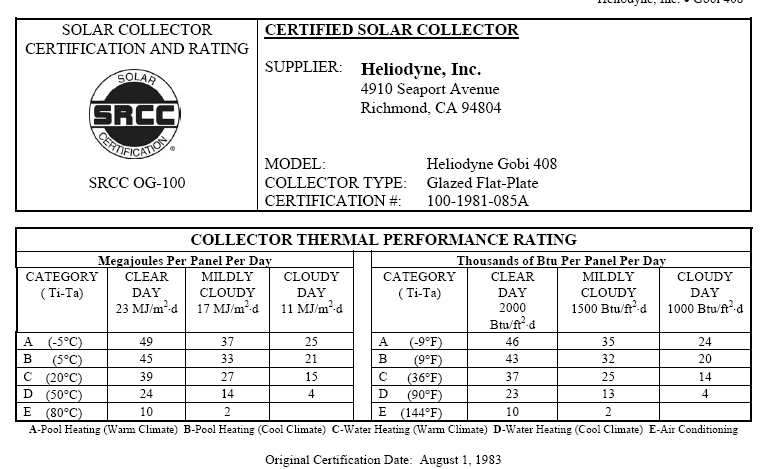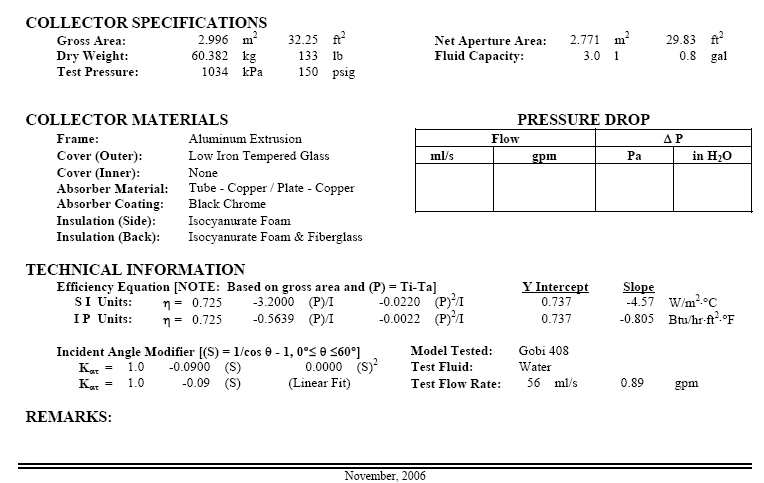
Search
The Renewable Energy site for Do-It-Yourselfers
Sample SRCC Rating
Page
|
The SRCC rates solar air and water
heating collectors. The rating includes a number of durability related
tests as well as a test of the panel heat output and efficiency.
Since the test is done the same way on every collector, its provides a good way
to compare panels on an apples to apples basis. You can also compare
different types of collectors -- for example, flat plate collectors compared to
evacuated tube collectors.
This page includes a sample page from the SRCC Directory
of SRCC Certified Solar Collector Ratings, along with some thoughts on how to
use these rating sheets to compare the performance of collectors. The
download below has these ratings for dozens of collectors, including plastic
pool collectors, flat plate collectors and evacuated tube collectors.
There are (unfortunately) very few solar air heating collectors.
These ratings take a lot of the
supplier BS out of comparing collectors from different makers. You may be
very surprised to see how some of these collectors compare.
|
|
Remember that these ratings give the
heat output for collectors, but say nothing about the cost of the collector.
If brand A's collector puts out a few more BTU per day than brand B's
collector, but it costs twice as much as brand B, then brand B is still the
better buy even though it puts out a bit less heat. The notes below tell
you how to estimate the heat output per dollar spent, which is what most people
are interested in.
You can download the full directory
of SRCC ratings here:
http://www.solar-rating.org/RATINGS/RATINGS.HTM
The actual directory is this file:
Directory of SRCC Certified Solar Collector Ratings
Collector Heat Output
The performance and characteristics
of each collector is summarized on a one page report. The sample below is
for a water heating collector.
The table in the top part of the page
provides the heat output for the collector for the standard SRCC tests.

The left half of the table gives test
results in metric units, and the right have in US units.
Since various collector designs
perform differently under different sun conditions, the SRCC gives the heat
output for clear sky, mildly cloudy and cloudy days. And, because
collectors perform differently depending on how much temperature difference
there is between the collector temperature and the outside ambient temperature, the heat
output is given for various various types of service that require heating water
or air
to different temperatures.
Sun Condition Category:
Clear Day -- The panel receives 2000
BTU per sqft over the full day
Mildly Cloudy -- The panel
receives 1500 BTU per sqft over the full day
Cloudy Day -- The panel
receives 1000 BTU per sqft over the full day
Note that these definitions will not
correspond exactly to your location. For example, a properly tilted panel
in a location in the mid US might receive anywhere from 1600 to 2300 BTU per
sqft on a clear day depending on the time of year.
Service Category:
The SRCC rates the panels for 5 kinds
of service:
Category A - Pool heating in a
warm climate -- Tinlet - Tambient = -9F
This service covers pool heaters in
warm climates where typically the ambient temperature is actually warmer than
the pool water going through the collector. These collectors are often
unglazed and made from plastic or EPDM rubber.
Category B -- Pool Heating in a
cool climate -- Tinlet - Tambient = +9F
Similar to category A, but with a
lower ambient temperature.
Category C -- Water Heating in a warm
climate -- Tinlet - Tambient = +36F
This service would apply to water
heating in a warm climate.
This might be the most generally
applicable category for water and space heating for people living in southern US
climates.
Category D -- Water Heating in a cool
climate -- Tinlet - Tambient = +90F
This service would apply to water
heating in a cooler climate that Category C
This might be the most generally
applicable category for water and space heating for people living in mid to
northern US climates.
E -- Air conditioning or industrial
uses -- Tinlet - Tambient = +144F
This is for applications where very
high temperature output is needed.
This category does not apply to most
consumer applications.
You will note that the panel output
drops as you progress from category A to B to C... E. This is because each
category requires the panel to put out hotter water relative to the outside
temperature -- this increases the heat loss from the panel and decreases
efficiency and output.
So, for most people, the right choice
will be category A or B for pool heating, or category C or D for water heating
and space heating.
Panel Output:
The panel output is given in
thousands of BTU for the whole day for the whole panel. For this panel,
under Mildly Cloudy conditions, and in Service D (domestic water heating), the
panel produces 13,000 BTU over a full sunny day.
When comparing panels of different
sizes, its important to remember that the output is given for the full panel,
so, if you want to compare panels on an equal basis, divide the panel output by
the panel area -- so this panel has an output per sqft of (13000/32.25 sqft) =
403 BTU per square foot of collector area.
Panel Description
The bottom half of the SRCC rating
page gives the physical description of the panels, and also provides the
efficiency curve parameters.

So, for this panel, the gross area is
32.25 sqft, of which 29.83 sqft actually collects sun.
It has an aluminum frame, and is
single glazed with tempered glass. The glass is "low iron" -- this makes
it more transparent than common glass, which has iron in it. It is
tempered to make it resistant to breaking under thermal and mechanical stress.
The absorber plate is made from
copper tubes and fins, and the fins are coated with a Black Chrome selective
coating (which makes it more efficient than black paint, but adds to the cost).
The back and sides of the panel are
insulated with Polyisocyanurate insulation -- a high performance urethane based
rigid insulating foam board.
Comparing Panels
You can compare two panels by first
deciding on the service category (A trough E) that represents your use.
Then look up the output for the three sun conditions for each panel. Then
divide the panel outputs by the area of the panel. This will allow
you to compare the two panels output per square foot for sunny to cloudy
conditions.
You should then figure out the price
per square foot of the panels you are comparing by dividing the panel price by
the panel are.
This tells you which of the
collectors produces the most heat for the least cost. There may, of
course, be other factors that enter in, such as quality of construction,
warrantees, ... but, this gives you a good place to start.
You may find in comparing two
collectors that one does better in sunny conditions while the other does better
under cloudy conditions. All things being equal, it is more important for
a collector to do better under sunny conditions than under cloudy conditions,
just because there is more heat to capture on sunny and partly sunny days than
on cloudy days. The exception to this might be if your full usage season
is very cloudy.
Here is a
full example done by Alan on comparing
several candidate collectors for a solar water heating application he is
designing.
Gary 1/15/07, updated 5/24/07,
updated 5/25/07


